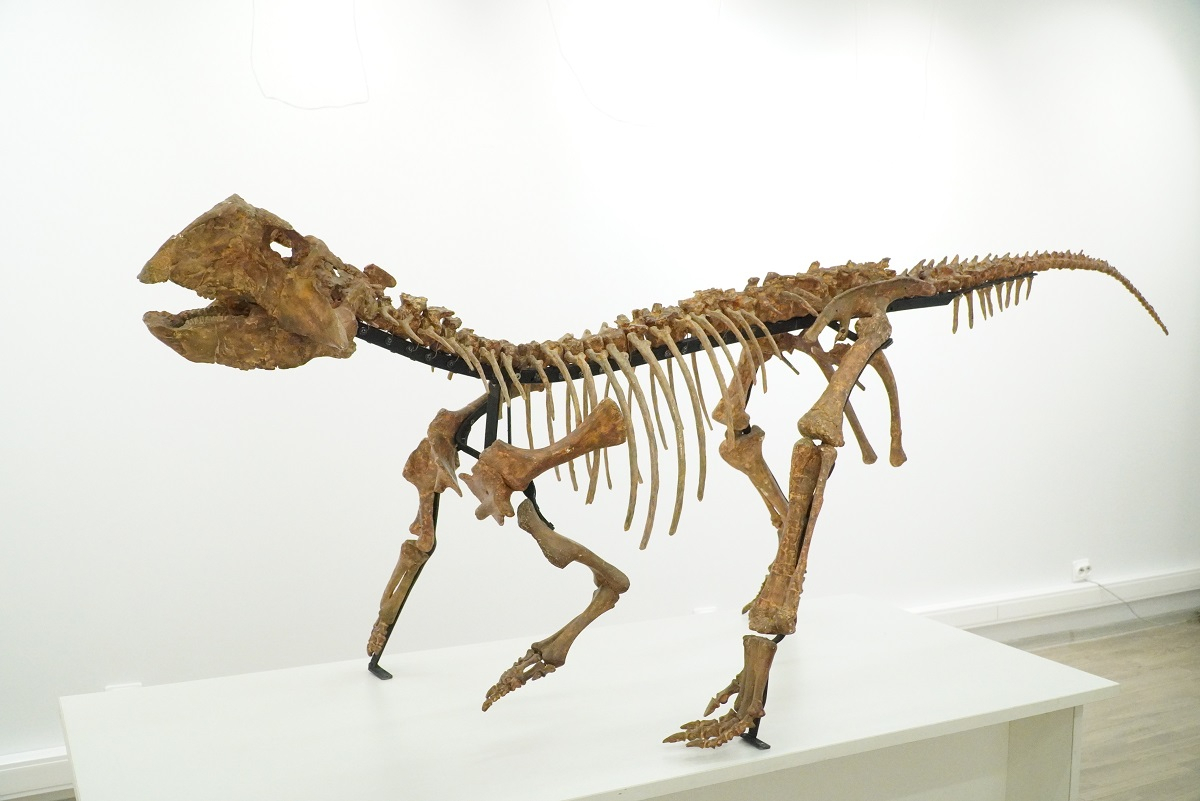A replica of a skeleton of Psittacosaurus sibiricus from Kuzbass on display at St Petersburg University

From 14 March to 13 May 2024, St Petersburg University will host the exhibition "Dinosaurs on the map of Russia", dedicated to the 300th anniversary of St Petersburg University. Visitors will be able to see a 3D copy of a fossil skeleton of a Psittacosaurus sibiricus lent to the Palaeontology Museum of St Petersburg University by the Kemerovo Regional Museum of Local History.
Psittacosaurus dinosaurs were an early, primitive genus of ceratopsian dinosaurs from the Early Cretaceous, distantly related to famous Triceratops. Unlike their three-horned relatives, Psittacosaurs had neither large horns, nor a bony neck frill that surrounded the head like a huge collar. Nevertheless, there are a significant number of skull bone outgrowths on its jugal, postorbital and jaw bones. Contrary to popular belief, Psittacosaurus was a rather large animal of the time, with a body length of up to 250 centimetres. In fact, Psittacosaurus sibiricus is the largest-known species of Psittacosaurus, of which there are about a dozen.
Experts of the Palaeontological Museum at St Petersburg University have received a copy of the fossil skeleton of Psittacosaurus sibiricus, created using 3D printing technology. This dinosaur species, along with many others that lived during the Early Cretaceous period, 120-125 million years ago, was discovered at the well-known Shestakovo fossil locality in the Kemerovo Region of Russia. St Petersburg University palaeontologists have been taking active part in excavations in Shestakovo, carried out by the Kemerovo Regional Museum of Local History.
Our exhibition will be dedicated to all dinosaur fossils found in Russia, and Siberian Psittacosaurus is one of Russia’s most recognisable dinosaurs.
Dmitry Grigoriev, Head of the Palaeontology Museum at St Petersburg University
'Psittacosaurus sibiricus even features on the flag and coat of arms of the Chebulinsky District in the Kemerovo Region, where it was found. The Kemerovo Regional Museum of Local History agreed to lend us a 3D model of its skeleton for the duration of our exhibition so that all visitors of our exhibition could see it,' said Dmitry Grigoriev, Head of the Palaeontology Museum at St Petersburg University.
Along with the 3D model of the Psittacosaurus skeleton, the exhibition will also feature a full-size reconstruction of that dinosaur made by palaeoartist and sculptor Valentin Popov. Thus, the audience will be able to see not only the skeleton, but also what this animal must have looked like.
For the first time, all dinosaur fossils found in Russia will be presented in one exhibition. The centrepiece of the exhibition will be a two-metre long limb bone of an Amurosaurus, or a duck-billed dinosaur, donated by the Laboratory of Palaeontology at the Institute of Geology and Nature Management, Far Eastern Branch of the Russian Academy of Sciences as a gift for the 300th anniversary of St Petersburg University. Also, visitors will be able to see other real dinosaur bones, 3D models of skeletons, skulls and individual bones, as well as dinosaur reconstructions from the collections of the Palaeontological Museum and the Department of Vertebrate Zoology at St Petersburg University, the Zoological Institute of the Russian Academy of Sciences, and the Kemerovo Regional Museum of Local History.
St Petersburg University has long been working with the Kemerovo Regional Museum of Local History. Academics and students of St Petersburg University regularly take part in joint palaeontological research. Students in the palaeontology programme at St Petersburg University have the opportunity to do fieldwork at the Shestakovo locality, where the Kemerovo Regional Museum of Local History annually conducts palaeontological excavations. Additionally, Professor Pavel Skutschas, Acting Head of the Department of Vertebrate Zoology at St Petersburg University, takes part in an annual scientific symposium within the framework of the International Popular Science Festival "Dinoterra", held at the Shestakovo fossil locality during the summer field season.
The exhibition project aims to: showcase the findings of Russian dinosaur research of the last three decades; illustrate the history of the study of dinosaurs found in Russia and scientific discoveries of Russian palaeontologists; and introduce contemporary palaeontological methods that enable researchers to visualise anatomical details and internal structures of a dinosaur’s brain.
Real expedition footage from dinosaur fossil sites; palaeontological fieldwork, and the processes that a fossil specimen undergo after having been excavated and before being displayed in an exhibition hall, including: conservation and preservation; dissection; and reconstruction of the animal’s appearance using 3D scanning, modelling and printing technologies, will be delivered in multimedia format.

